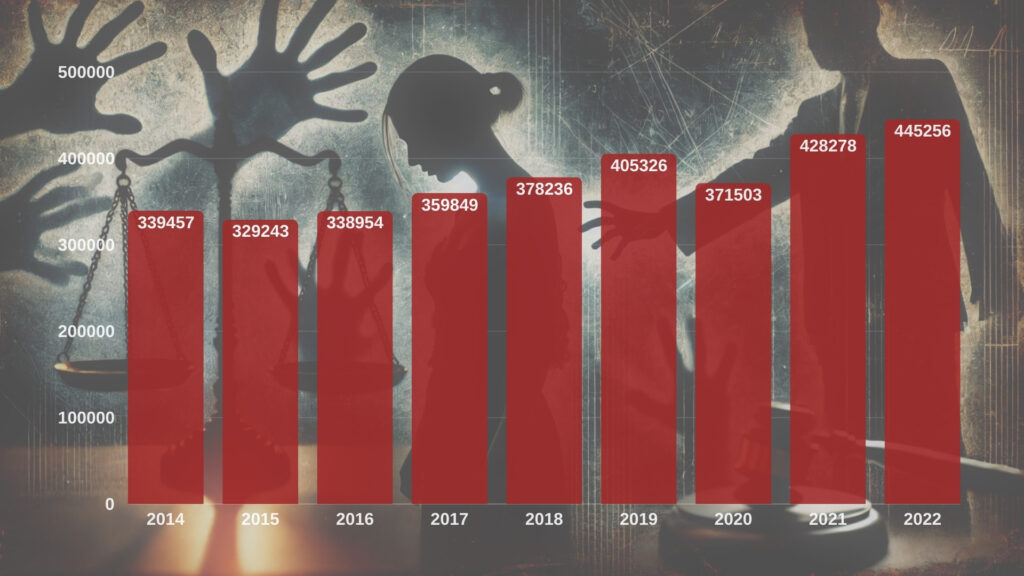The tragic case of Atul Subhash’s suicide has rocked the nation. The case has divided everyone into two primary sections. On one side, people are siding with Atul’s wife and saying that her story should be heard too. On the other hand, the other side wants the misuse of pro-women laws in the country to be addressed. There is a small section of people, like me, who have seen cases going bad from both sides. In my view, the laws should be gender-neutral, and no one should be allowed to misuse them in any case. I am not going to discuss Atul’s case; rather, I will prefer to discuss both sides in general and the need to bring some neutrality to the law.
We are living in 2024. The crimes against women are high as always. As more cases are being reported nowadays with 24×7 media looking for “mirch-masala,” the numbers seem to become grimmer with every passing day.
Interpreting the numbers
According to data presented in Lok Sabha in July 2024, reported crimes against women rose from 3,39,457 in 2014 to 4,45,256 in 2022. The numbers are scary. Going by the numbers, every day, 1,220 cases of crimes against women were reported.

Now, there is an interesting aspect to the numbers. In 2019, the reported cases were 4,05,326, and in 2020, the cases reported were 3,71,503. Does that mean 2020 was better for women? No, I don’t think so. The number was lesser just because of the COVID-19 pandemic. This is why I am using the phrase “cases reported” and not suggesting that crimes against women are on the rise.
I believe that because of stronger laws in favour of women, they are coming out in larger numbers seeking justice. The crime against women was always there, but because of the lethargic nature of the justice system, police, and bureaucracy, they were not inclined to report the cases. Take the example of the 1992 Ajmer gangrape and blackmail case.
The last accused in the case were sentenced in 2024, 32 years after the case shook the nation because of its sheer magnitude. I believe that case is still not over as the convicts have options of going to higher courts. Imagine the pain victims have to suffer for decades when they are called for hearings and have to relive what they went through 30+ years ago. In such cases, victims and witnesses often become hostile, and the case goes to the cold box forever.
The only way out is fast-track courts and time-bound hearings in cases. But does that solve the problem? Actually, no. According to data provided in Lok Sabha in August 2024, there are 83,589 cases pending in the Supreme Court of India. In High Courts, there are 59,95,569 cases pending, and in District and Subordinate Courts, there are 4,45,41,614 cases pending.
Furthermore, there are 13,44,894 cases pending in fast-track courts and 2,34,712 cases pending in village courts. Since August, the number would have increased further.
The challenge of judicial delays
With the mountainous number of cases pending, it is obvious that people think thrice before going to the police and judiciary. Things have slightly changed because of the more stringent laws, but change cannot happen just by making laws. The whole system needs a revamp, and it was needed yesterday.
Now, coming to the misuse of laws that are in place to curb crime against women. Following Atul’s suicide, the apex court made a remark while hearing a different case that Section 498A, which penalises cruelty by husbands and their families against women, is being massively misused.
During the hearing of a case, the bench comprising Justice BV Nagarathna and Justice N Kotiswar Singh noted that while some laws were originally meant to protect women against domestic violence and harassment, they are being widely misused by some women to compel husbands and their families into complying with unreasonable demands. Moreover, laws like Section 498A of the Indian Penal Code are being misused by some wives to unleash personal vendettas against husbands and their families.
The misuse of pro-women laws reminds me of the 1769 doctrine or the Blackstone’s ratio, an idea expressed by English jurist William Blackstone, which says it is better for ten guilty people to go free than for one innocent person to be convicted. The exact quote from William Blackstone states, “It is better that ten guilty persons escape than that one innocent suffer.”
The principle is at the core of any justice system, and judges, from time to time, refer to it in their own way. The essence of the doctrine is lost when laws like Section 498A are misused. False cases not only destroy lives but also dilute the seriousness of genuine cases, making it harder to bring real culprits to justice.
Real-life cases of misuse and genuine grievances
Let’s discuss some of the cases that happened around me, which make it easier to understand that bad actors are on both sides.
Case 1: A young marriage turned bitter
There was a distant relative of mine who got married at an early age. When I say early, the boy was only 21, and the girl was only 19 when they got married. It was an “arranged marriage” setting. The first couple of years, at least for us who were not aware of their family dynamics, seemed fine. They had a child, which, according to me, was too early, but anyway. However, in the next couple of years, things went haywire.
One fine day, the wife went to her parents’ house and never came back. She took the kid with her, and after a few days, a “panchayat” was called as she wanted a divorce. I won’t say she did not face any issues at my relative’s house, but the way things turned around next was not what I was hoping for, to say the least.
The “panchayat” did not come to a favourable conclusion, and a court case was filed. As the cousin’s family lived with old grandparents, they were also dragged into the case. The basic ordeal went along, including dowry, harassment, assault, and whatnot. It took my relative ten years to get the child back. Meanwhile, the ex-wife got remarried, and the new husband was not fond of the child from the first marriage. There were signs of assault and harassment when he finally came to his dad’s house. It took another year for the kid to feel “normal.”
Case 2: A hidden addiction and broken trust
Before this male relative’s ordeal, another matter happened in a distant relative’s family where a female relative got married in an “arranged marriage” setting. On the first night, a horrifying discovery was made that the man was not only an addict but also had a huge, scary scar that ran from neck to waist. It took a couple of months for things to get sorted out, and she filed for a divorce. As far as I know, she is still single, and it has been over 20 years since this happened.
Case 3: A perfect wedding with an imperfect ending
One of my schoolmates was in a relationship for ten years before getting married to his college sweetheart. It was a lavish wedding, and families on both sides were happy with all the arrangements. Both families were well-off, so they did exchange a lot of “gifts.” It was one of those weddings where you go, “People in my circle have this much money? Really?” Everything went well for six months till she got pregnant. In my schoolmate’s words, she started to behave weirdly.
They were living in the city where her parents and all relatives lived, so she started spending a lot of time at their houses. Fast forward, after six months of the birth of their child, she decided to go to her parents’ house, never to come back. My classmate was not aware of what was happening at her house, but they decided she wanted a divorce. My classmate told me there were no arguments or fights between them, and it was echoed by his wife as well when I met her after the divorce.
However, a divorce case was filed with the basic allegations, including cases against his parents (who live in a small city over 300 km away), harassment, dowry, and whatnot. Interestingly, photos of “gifts” were used as evidence of dowry. My classmate was a wealthy man and claimed to have never asked for anything apart from the girl. He spent one month in jail with no hope for bail or trial. It took three years for the divorce to finalise. He is still single. The girl got married again to a family friend’s son.
Case 4: Lies in an arranged marriage
One of my friends got married in the early 2010s. It was an arranged marriage setting, and the boy was chosen via a middleman, which is common in their families. Because there was a person involved and families generally trust the middleman, I think there was some lack of getting the boy checked on their own by her family.
In the first week of marriage, everything was fine. However, she started to notice some changes in his behaviour as if he was having withdrawal symptoms. It turned out he was an addict. She was forced not to tell her parents, and she did the same for two months till it became intolerable. She informed her parents. Initially, the husband’s family denied the allegations, but later they admitted to lying while finalising the marriage.
It took my friend one year to get out of that horrible house. She is still single. I am not sure if that dude got remarried or not. They had a mutual divorce. My friend did not file any case against them as she wanted to get out of it as soon as possible.
The need for neutral laws
There are many more cases that I know where marriages broke or were saved due to the intervention of relatives, but the point I want to emphasise can be made clear with these four cases. It is evident that bad actors are everywhere, and you cannot be sure if the man or the woman in a marriage is going to turn evil.
Having said that, there is a need for neutral laws or at least some way out for men to save themselves from false cases. I am not asking to tone down the laws completely as crimes against women are going to happen, and there is no way any law can stop it. But the lawmakers and the judiciary have to draw a line. They have to come up with a solution to weed out false cases as they are ruining our society.
Justice for all
A victim cannot be defined just by gender. Evil resides in both genders. It is essential to ensure those who commit crimes against women are punished. At the same time, it is essential to ensure no innocent man has to go through the torture of a false case. Mediators, family courts, counsellors, judges, advocates, police, lawmakers, and other stakeholders need not be only pro-women. They have to behave in a somewhat neutral manner to ensure justice is on the right side, with the right person. They must remember that when a false case is filed, there are women who suffer alongside the man facing the false case.
Also, there is a need for strict laws against those who file false cases so that they face the consequences as well. Let it be the woman or the man; whoever is the victim should get justice. Let it be the woman or the man; whoever is the culprit should be punished.
You can read this article on X by following this link – https://x.com/LekhakAnurag/status/1867942933682369017










